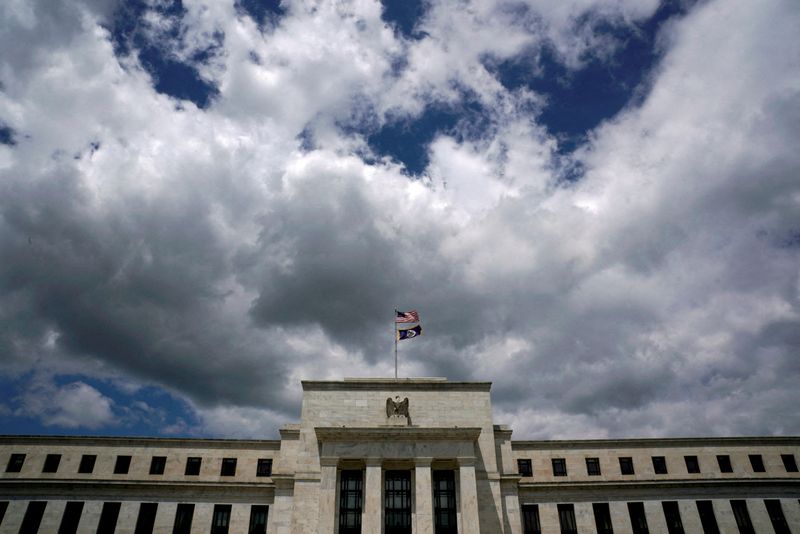Explainer-Charting the Fed's economic data flow
Reuters
Published Feb 02, 2024 09:28AM ET

(Reuters) - The Federal Reserve held its benchmark overnight interest rate steady in the 5.25%-5.50% range at the end of its Jan. 30-31 policy meeting, but said it would consider reducing it once it is more confident inflation will continue falling to the U.S. central bank's 2% target. Upcoming data on inflation, jobs and consumer spending will shape the timing of that decision.
The Fed will hold its next policy meeting on March 19-20. Here is a guide to some of the numbers shaping the policy debate:
EMPLOYMENT (Released Feb. 2; next release March 8):
U.S. firms added 353,000 jobs in January. That was up from the sharply higher revised gain of 333,000 jobs in December.
The unemployment rate remained steady at 3.7%.
Fed officials have become more comfortable with the idea that continued strong job growth could still allow inflation to fall. But the growth in January was nearly double what economists expected, and the job gains occurred across a broad set industries, dispelling concern that hiring had become too focused.
The latest report may not shift views greatly at the Fed about the coming path of inflation, but it may do little to advance arguments for cutting rates sooner rather than later.
Wage growth jumped to an annual 4.5% after showing signs of cooling. While Fed Chair Jerome Powell has said wage growth adjustments could take place over time, and recent strong productivity gains help mute any impact that wage increases may have on prices.
Still, the January level is well above the 3.0%-3.5% range that most policymakers view as consistent with the Fed's 2% inflation target.
JOB OPENINGS (Released Jan. 30; next release March 6):
Fed Chair Jerome Powell keeps a close eye on the U.S. Labor Department's Job Openings and Labor Turnover Survey (JOLTS) for information on the imbalance between labor supply and demand, and particularly on the number of job openings for each person who is without a job but looking for one. The ratio had been falling steadily towards its pre-pandemic level, but has risen in the last two months and remains above 1.4-to-1, higher than the 1.2-to-1 level seen before the health crisis. Other aspects of the survey, like the quits rate, have edged back to pre-pandemic levels.
INFLATION (PCE released Jan. 26; next release CPI Feb. 13)
The personal consumption expenditures (PCE) price index, by which the Fed measures inflation, rose 0.2% in December from the prior month, in line with economists' expectations and translating to an annualized pace in keeping with the Fed's 2% target.
On a three-month and six-month annualized basis, underlying core PCE inflation excluding food and energy prices is running below target, the data showed, and from a year ago the increase was 2.9%, the smallest rise since March 2021.
Meanwhile, a report in January showed the consumer price index (CPI) jumped 3.4% on a year-on-year basis in December from 3.1% in the prior month, while the core rate edged down to 3.9% from 4.0%, stronger-than-expected readings that underscored the bumpy path back to the Fed's target.
Fed officials will look to annual revisions on the CPI due to be released on Feb. 11 for further clues on the path of inflation; revisions last year undid what had looked like progress seen until that point.

RETAIL SALES (Released Jan. 17; next release Feb. 15):
Retail sales rose 0.6% in December, yet another in what has been a string of "upside surprises" the economy delivered over the course of 2023. The surge in spending foreshadowed the far-stronger-than-expected 3.3% estimate for annualized fourth-quarter GDP growth released on Jan. 25. Fed policymakers have been anticipating signs the aggressive rate hikes they delivered from March 2022 to July 2023 are trimming overall demand for goods and services, but that progress has been hard to detect.
Written By: Reuters
Trading in financial instruments and/or cryptocurrencies involves high risks including the risk of losing some, or all, of your investment amount, and may not be suitable for all investors. Prices of cryptocurrencies are extremely volatile and may be affected by external factors such as financial, regulatory or political events. Trading on margin increases the financial risks.
Before deciding to trade in financial instrument or cryptocurrencies you should be fully informed of the risks and costs associated with trading the financial markets, carefully consider your investment objectives, level of experience, and risk appetite, and seek professional advice where needed.
Fusion Media would like to remind you that the data contained in this website is not necessarily real-time nor accurate. The data and prices on the website are not necessarily provided by any market or exchange, but may be provided by market makers, and so prices may not be accurate and may differ from the actual price at any given market, meaning prices are indicative and not appropriate for trading purposes. Fusion Media and any provider of the data contained in this website will not accept liability for any loss or damage as a result of your trading, or your reliance on the information contained within this website.
It is prohibited to use, store, reproduce, display, modify, transmit or distribute the data contained in this website without the explicit prior written permission of Fusion Media and/or the data provider. All intellectual property rights are reserved by the providers and/or the exchange providing the data contained in this website.
Fusion Media may be compensated by the advertisers that appear on the website, based on your interaction with the advertisements or advertisers.